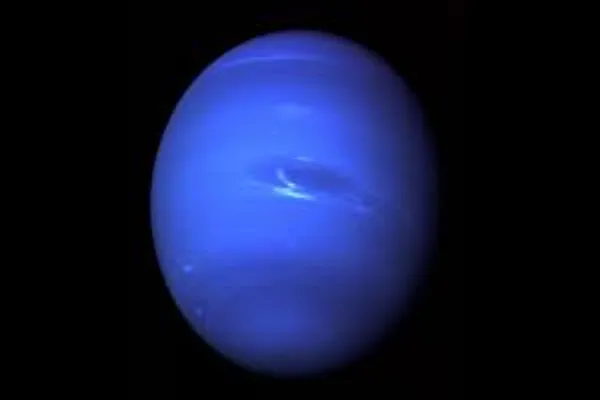10 Facts About Neptune

Neptune Uncharted: 10 Facts About Neptune, the Blue Giant of the Outer Solar System
Neptune, the eighth and farthest known planet from the Sun, is a mysterious and distant giant that beckons exploration. Dive into the depths of Neptune’s enigmatic realm with these 10 facts about Neptune that illuminate its unique characteristics and contributions to our understanding of the outer solar system.
1. Vibrant Blue Atmosphere: Neptune’s atmosphere showcases a stunning blue hue, primarily attributed to the presence of methane gas. The absorbing properties of methane selectively scatter sunlight, giving Neptune its captivating azure appearance.
2. Stormy Weather: Neptune is home to some of the most powerful storms in our solar system. The Great Dark Spot, a storm system similar to Jupiter’s Great Red Spot, was observed by the Voyager 2 spacecraft during its flyby in 1989. Since then, the Great Dark Spot has dissipated, but other storms, like the Great White Spot, have been identified in subsequent observations.
3. Rapid Winds: Neptune boasts some of the fastest winds in the solar system, with velocities reaching up to 1,200 miles per hour (1,930 kilometers per hour). These high-speed winds are believed to be driven by the planet’s internal heat and its tilted rotation axis.
4. The Ice Giant Duo: Similar to Uranus, Neptune is classified as an ice giant due to its composition, which includes water, ammonia, and methane ices. This classification sets Neptune and Uranus apart from the gas giants Jupiter and Saturn.
5. Neptune’s Rings: Neptune has a faint but intricate ring system composed of dark, narrow rings. These rings, primarily composed of dust particles, are named after astronomers who made significant contributions to the study of the planet, including the Adams, Le Verrier, Galle, and Lassell rings.
6. Dynamic Magnetic Field: Neptune possesses a highly tilted and lopsided magnetic field, offset from its center by about 47 degrees. This peculiar magnetic field, coupled with its rapid rotation, creates complex magnetic interactions that contribute to the planet’s dynamic atmosphere.
7. Neptune’s Moon Triton: Triton, Neptune’s largest moon, is an intriguing world in its own right. It is the only large moon in the solar system that exhibits a retrograde orbit, meaning it orbits Neptune in the opposite direction of the planet’s rotation. Triton’s unique characteristics suggest that it may have been captured by Neptune’s gravity, rather than forming in orbit around the planet.
8. Voyager’s Grand Tour: The Voyager 2 spacecraft, humanity’s only visitor to Neptune, conducted a flyby in 1989, providing valuable insights into the planet’s atmosphere, rings, and moons. The data collected by Voyager 2 continues to shape our understanding of Neptune and its place in the outer solar system.
9. The Discovery of Neptune: Neptune was not discovered through traditional observations with a telescope but rather through mathematical calculations. In the mid-19th century, astronomers Urbain Le Verrier and John Couch Adams independently predicted the existence and location of Neptune based on gravitational perturbations observed in the orbit of Uranus.
10. Neptune’s Unique Rotation: Neptune, like Uranus, experiences a retrograde rotation, meaning it rotates on its axis in the opposite direction to most planets. This rotational peculiarity, combined with its fast rotation and tilted magnetic field, contributes to the complex and dynamic nature of Neptune’s atmosphere.
Mysteries of the Ice Giant Through 10 Facts About Neptune

Neptune, the distant and majestic ice giant, reveals a plethora of intriguing facts that make it a captivating subject of astronomical study. Its vibrant blue atmosphere, tinged by the presence of methane, sets Neptune apart as a celestial beauty. This hue is not merely aesthetic; it is a result of the selective scattering of sunlight by methane particles in the atmosphere.
Beyond its striking appearance, Neptune is known for its tempestuous weather, hosting powerful storms that rival the intensity of any seen in our solar system. The legacy of the Great Dark Spot, a massive storm observed by the Voyager 2 spacecraft in 1989, has paved the way for ongoing studies of Neptune’s atmospheric dynamics and the emergence of subsequent phenomena, such as the Great White Spot.
Neptune’s winds, clocking in at speeds up to 1,200 miles per hour (1,930 kilometers per hour), are some of the fastest in the solar system. These rapid winds are thought to be generated by the planet’s internal heat and its tilted rotation axis, contributing to the ever-changing patterns in Neptune’s atmosphere.
As Voyager 2 conducted its historic flyby, it unveiled not only the turbulent weather of Neptune but also the planet’s faint but intricate ring system, comprised of dark, narrow rings named in honor of astronomers who made significant contributions to the understanding of the planet. The mysteries surrounding Neptune, from its unique magnetic field to the peculiar orbital characteristics of its moon Triton, continue to beckon scientists and stargazers alike into the depths of the outer solar system.
Neptune, with its brilliant blue visage and dynamic features, remains a tantalizing subject for astronomers and space enthusiasts. As we continue to unravel the 10 facts about Neptune and the mysteries of this distant giant, each discovery adds to the rich narrative of our exploration of the outer reaches of the solar system.